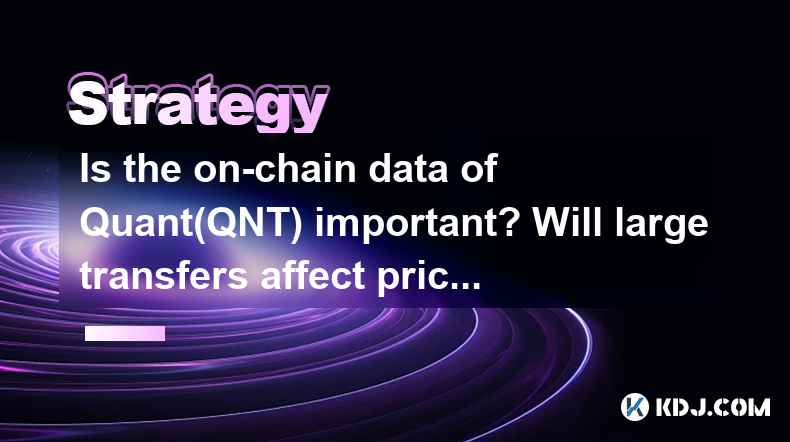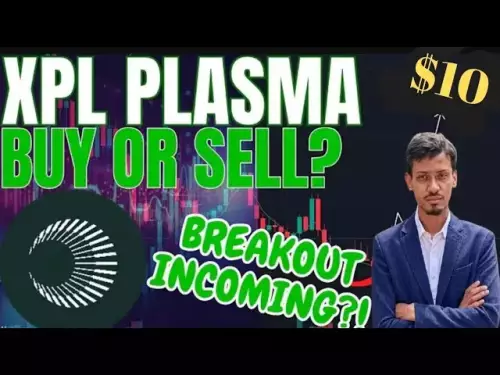-
 bitcoin
bitcoin $110918.433029 USD
-1.69% -
 ethereum
ethereum $3996.872473 USD
-2.43% -
 tether
tether $1.000594 USD
0.00% -
 bnb
bnb $1178.871834 USD
-2.38% -
 xrp
xrp $2.413973 USD
-3.47% -
 solana
solana $194.341461 USD
-4.24% -
 usd-coin
usd-coin $0.999963 USD
-0.03% -
 tron
tron $0.320092 USD
0.92% -
 dogecoin
dogecoin $0.196919 USD
-3.42% -
 cardano
cardano $0.669585 USD
-3.63% -
 hyperliquid
hyperliquid $37.485952 USD
-3.58% -
 ethena-usde
ethena-usde $1.000026 USD
-0.02% -
 chainlink
chainlink $18.018220 USD
-5.13% -
 bitcoin-cash
bitcoin-cash $523.879267 USD
-2.41% -
 stellar
stellar $0.324655 USD
-3.67%
Is the on-chain data of Quant(QNT) important? Will large transfers affect prices?
On-chain data is crucial for understanding Quant (QNT)'s health, with large transfers impacting prices; tools like Etherscan help monitor these dynamics for informed investment decisions.
May 02, 2025 at 04:49 am

Is the On-Chain Data of Quant (QNT) Important?
The on-chain data of Quant (QNT) is indeed crucial for understanding the health and dynamics of the cryptocurrency. On-chain data refers to the information recorded on the blockchain, which includes transaction volumes, wallet addresses, large transfers, and other metrics. This data provides a transparent view of what is happening within the network, allowing investors and analysts to make informed decisions.
Understanding On-Chain Data
On-chain data for Quant (QNT) includes a wide range of metrics that can be analyzed. These metrics include transaction volume, active addresses, network hash rate, and large transfers. Each of these metrics offers a different perspective on the network's activity and health. For instance, an increase in transaction volume may indicate growing interest in the cryptocurrency, while a surge in active addresses could suggest broader adoption.
The Impact of Large Transfers on QNT Prices
Large transfers of Quant (QNT) can indeed have an impact on the cryptocurrency's price. Large transfers are typically defined as transactions involving a significant amount of QNT being moved from one wallet to another. These transfers can signal various things, such as whales (large holders) moving their assets, institutional investors adjusting their positions, or even exchanges managing their liquidity.
When a large transfer occurs, it can cause market participants to react. If the transfer is perceived as a sell-off by a whale, it might lead to a temporary dip in the price due to increased selling pressure. Conversely, if the transfer is seen as an accumulation by a large investor, it might be interpreted as a bullish signal, potentially driving the price up.
Analyzing Large Transfers
To understand the impact of large transfers on Quant (QNT), it's essential to analyze the context and frequency of these movements. Analyzing large transfers involves looking at the source and destination of the funds, the timing of the transfer, and any subsequent market reactions. Tools like blockchain explorers and on-chain analytics platforms can help in this analysis.
For instance, if a large transfer is made from a known exchange wallet to a cold storage wallet, it might be interpreted as an exchange reducing its exposure to QNT, which could be bearish. On the other hand, if a large transfer is made from a cold storage wallet to an exchange, it might signal an intention to sell, potentially putting downward pressure on the price.
Case Studies of Large Transfers and Price Movements
There have been several instances where large transfers of Quant (QNT) have coincided with significant price movements. In one case, a large transfer of QNT from a whale's wallet to an exchange was followed by a noticeable dip in the price. This event was closely monitored by market participants, and the subsequent selling pressure led to a short-term decline in the price.
In another instance, a series of large transfers from institutional wallets to cold storage was interpreted as a bullish signal, leading to a surge in the price of QNT. These transfers were seen as long-term holders accumulating more QNT, which instilled confidence in other investors and drove the price higher.
Tools for Monitoring On-Chain Data
There are several tools available for monitoring the on-chain data of Quant (QNT). Some of the most popular tools include:
- Blockchain Explorers: Platforms like Etherscan allow users to track transactions, addresses, and other on-chain activities related to QNT.
- On-Chain Analytics Platforms: Services like Glassnode and CryptoQuant provide detailed analytics on large transfers, transaction volumes, and other metrics.
- Market Intelligence Tools: Tools like Messari offer comprehensive market intelligence, including on-chain data and price analysis for QNT.
Using these tools, investors can gain a deeper understanding of the on-chain dynamics of Quant (QNT) and make more informed trading decisions.
The Role of On-Chain Data in Investment Decisions
On-chain data plays a critical role in investment decisions for Quant (QNT). Investors use this data to assess the health of the network, identify potential trends, and make predictions about future price movements. For instance, an increase in transaction volume and active addresses might suggest growing interest in QNT, making it an attractive investment opportunity.
Similarly, monitoring large transfers can help investors gauge the sentiment of large holders and institutional investors. If whales are accumulating QNT, it might be a signal to buy, while large transfers to exchanges could be a warning sign of potential sell-offs.
Frequently Asked Questions
Q: How can I access on-chain data for Quant (QNT)?A: You can access on-chain data for Quant (QNT) using blockchain explorers like Etherscan, on-chain analytics platforms like Glassnode and CryptoQuant, and market intelligence tools like Messari. These platforms provide detailed information on transactions, large transfers, and other metrics.
Q: Are there any risks associated with relying on on-chain data for investment decisions?A: Yes, there are risks associated with relying solely on on-chain data. While on-chain data can provide valuable insights, it should be used in conjunction with other forms of analysis, such as technical and fundamental analysis. Additionally, on-chain data can sometimes be misleading if not properly contextualized.
Q: Can on-chain data predict the future price of Quant (QNT)?A: On-chain data can provide indicators and trends that might influence the future price of Quant (QNT), but it cannot predict the price with certainty. Market dynamics are influenced by a wide range of factors, and on-chain data is just one piece of the puzzle.
Q: How often should I monitor on-chain data for Quant (QNT)?A: The frequency of monitoring on-chain data depends on your investment strategy. For short-term traders, daily monitoring might be necessary to stay on top of market movements. For long-term investors, weekly or monthly checks might be sufficient to track broader trends and developments.
Disclaimer:info@kdj.com
The information provided is not trading advice. kdj.com does not assume any responsibility for any investments made based on the information provided in this article. Cryptocurrencies are highly volatile and it is highly recommended that you invest with caution after thorough research!
If you believe that the content used on this website infringes your copyright, please contact us immediately (info@kdj.com) and we will delete it promptly.
- Cryptos in Flux: MoonBull's Lunar Stampede, Solana's Struggle, and XRP's ETF Hopes
- 2025-10-17 06:25:11
- Remittix Presale, RTX Token, and DeepSnitch AI: The Next Big Thing in Crypto?
- 2025-10-17 07:25:17
- Bitcoin, Trump & Meme Coins: Newsmax's Bold Move & AlphaPepe's Rise
- 2025-10-17 07:25:17
- SEI Forms Inverse Head & Shoulders: Breakout Imminent?
- 2025-10-17 07:10:01
- Cardone Capital Dives Deeper: Why Grant Cardone is Buying More Bitcoin Now
- 2025-10-17 06:25:11
- Newsmax, Bitcoin, and Trump Coin: A Bold Crypto Play?
- 2025-10-17 07:10:01
Related knowledge

Practical parameter settings for a Bitcoin multi-timeframe moving average system
Sep 18,2025 at 10:54pm
Optimizing Timeframe Combinations for Bitcoin Trading1. Selecting appropriate timeframes is crucial when building a multi-timeframe moving average sys...

How can I filter out false breakouts in Dogecoin high-frequency trading?
Sep 22,2025 at 01:00am
Understanding False Breakouts in Dogecoin Trading1. A false breakout occurs when Dogecoin's price appears to move beyond a defined support or resistan...

Techniques for identifying tops and bottoms in the Bitcoin on-chain NVT model
Sep 20,2025 at 07:54pm
Understanding the NVT Model in Bitcoin Analysis1. The Network Value to Transactions (NVT) ratio is often described as the 'P/E ratio' of the cryptocur...

What does the surge in open interest in Bitcoincoin futures mean?
Sep 20,2025 at 11:18pm
Understanding the Surge in Dogecoin Futures Open Interest1. A surge in open interest within Dogecoin futures indicates a growing number of active cont...

How can I use the Ethereum USDT premium to gauge market sentiment?
Sep 18,2025 at 11:55pm
Understanding the Ethereum USDT Premium1. The Ethereum USDT premium refers to the price difference between USDT (Tether) traded on Ethereum-based plat...

What should I do if Ethereum staking yields decline?
Sep 20,2025 at 06:18am
Understanding the Causes Behind Declining Ethereum Staking Yields1. The Ethereum network transitioned to a proof-of-stake consensus mechanism with the...

Practical parameter settings for a Bitcoin multi-timeframe moving average system
Sep 18,2025 at 10:54pm
Optimizing Timeframe Combinations for Bitcoin Trading1. Selecting appropriate timeframes is crucial when building a multi-timeframe moving average sys...

How can I filter out false breakouts in Dogecoin high-frequency trading?
Sep 22,2025 at 01:00am
Understanding False Breakouts in Dogecoin Trading1. A false breakout occurs when Dogecoin's price appears to move beyond a defined support or resistan...

Techniques for identifying tops and bottoms in the Bitcoin on-chain NVT model
Sep 20,2025 at 07:54pm
Understanding the NVT Model in Bitcoin Analysis1. The Network Value to Transactions (NVT) ratio is often described as the 'P/E ratio' of the cryptocur...

What does the surge in open interest in Bitcoincoin futures mean?
Sep 20,2025 at 11:18pm
Understanding the Surge in Dogecoin Futures Open Interest1. A surge in open interest within Dogecoin futures indicates a growing number of active cont...

How can I use the Ethereum USDT premium to gauge market sentiment?
Sep 18,2025 at 11:55pm
Understanding the Ethereum USDT Premium1. The Ethereum USDT premium refers to the price difference between USDT (Tether) traded on Ethereum-based plat...

What should I do if Ethereum staking yields decline?
Sep 20,2025 at 06:18am
Understanding the Causes Behind Declining Ethereum Staking Yields1. The Ethereum network transitioned to a proof-of-stake consensus mechanism with the...
See all articles










































































